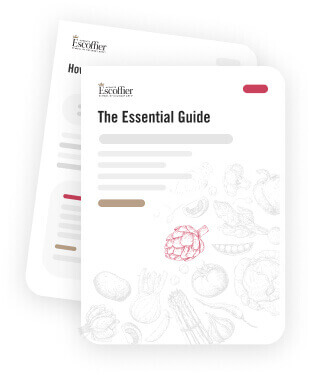Listen to This Article:
Sunday mornings wouldn’t be the same without the salty, crispy crunch of oven-fried potatoes, nor would a Fourth of July picnic be the same without a creamy potato salad. What do both dishes have in common? In the culinary world, the answer is perfectly cubed potatoes. An essential ingredient in soups and stews, curries, and fillings (and yes, potato salad), the cubed potato is the star of many a beloved plate.
Learning how to cube a potato is an important skill for culinary school students, chefs, sous chefs, and kitchen prep staff. As a culinarian, cutting your ingredients properly, with consistent sizing, ensures even cooking and a clean presentation of your finished dish. It may not seem like it at first glance, but cubing potatoes well helps create the sensory magic we all love when we bite into that potato dish. Let’s dive into how to cube a potato like a professional.
The Set Up: Prepare to Cube Potatoes
There’s really nothing fancy to getting a perfect dice. You only need a sharp knife and a cutting board to cube potatoes.
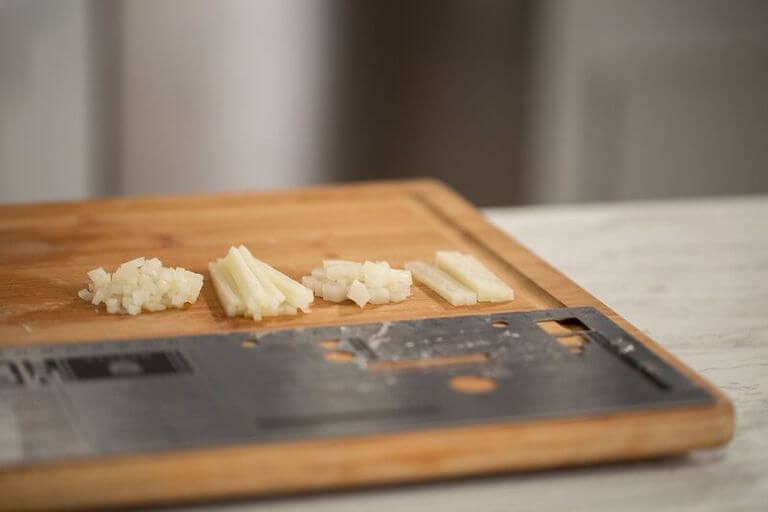
Using a culinary cutting ruler like this one can help you with sizing your potato cubes.
Simply start by washing the potatoes with a produce brush to remove dirt and cut out any bad spots. You can use any type of potato, including russets, yellow or golden potatoes, and red or purple potatoes, but starchy potatoes like russets or Yukon golds hold together best.
How to Choose the Perfect Potato for Your Dish
You can generally use any potato for your dish, but the starchiness can affect how your dish turns out. Here are some tips to help guide your choice.
- Russet potatoes are very starchy and great for potato salad, soups, potato filling, or breakfast potatoes.
- Yellow potatoes (like Yukon gold) are medium-starchy potatoes great for potato salad, pureed soups, curries, or breakfast.
- Red potatoes are a less starchy potato but are still good for breakfast potatoes or potato salad.
- Note: You can use purple potatoes or fingerling potatoes, but there may not be enough potato flesh to make it worth your while to use for cubing.
Prepping the potato this way removes the skin and leaves you with a block of potato that is ready to be cubed.
The Main Event: How to Cube a Potato
Now that you have your trimmed potato, decide which type of cube you’d like to cut. There are five different types of potato cubes, each a different size.
Potato Cube Sizes
- Large Dice: ¾” x ¾” x ¾”
- Medium Dice: ½” x ½” x ½”
- Small Dice: ¼” x ¼” x ¼”
- Brunoise (pronounced “broon-nwahz”): 1/8” x 1/8” x 1/8”
- Fine Brunoise: 1/16” x 1/16” x 1/16”
Choose the Right Potato Cube Size for Your Recipe
Each dice size has different culinary uses. Choosing the right-sized potato cube for your recipe will ensure that the potatoes are cooked just right and that the dish has the right texture and mouthfeel.
Choose a large dice for dishes where potatoes will be boiled or a medium dice for dishes where you’d like to highlight the potato, like breakfast potatoes, potato salad, curry, or a non-pureed soup. Choose brunoise or fine brunoise for dishes where the potatoes will disintegrate or be used as a filling, like with stuffed pasta or knishes.
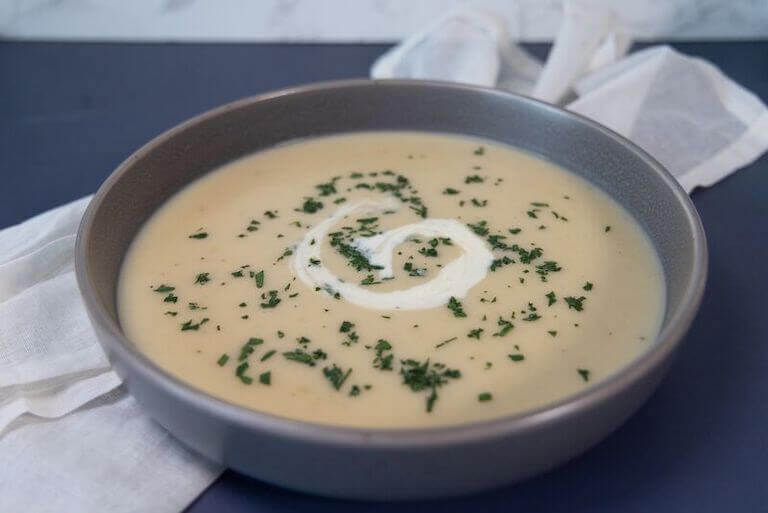
Use the largest dice size for dishes where the potatoes will be boiled, like this Irish potato soup.
4 Steps to Cubing Potatoes
To complete your potato cubes, follow these specific steps in order.
- First, cut a section from your block to the desired width. Use your culinary ruler to guide you. For this example, let’s imagine you’re planning to cut a large dice. You’ll estimate ¾” from the edge, and carefully cut a slice off the brick at that width. You now have a slab of potato ¾” wide.
- Next, turn your slab onto its flat side. Cut a section off of the slab at your desired dice width. In this example, you’ll cut a ¾” wide piece. Use your culinary ruler for precision. Now you have an even-width stick of potato, ¾” x ¾” x however long your original potato block was.
- Now, turn your potato stick and cut across it at the desired dice size to create ¾” potato cubes. Again, rely on your culinary ruler to get your dice just right.
- Repeat the process until your potato is completely diced.
The more evenly you cube the potato, the more evenly your dish will cook, and the better the final presentation.
The Two Most Common Potato Cubing Mistakes
If you’re an at-home culinarian, the perfection of your potato cubes probably doesn’t matter much. But in a professional kitchen, whether for a restaurant, hotel, or caterer, consistency and quality matter.
The two most common potato cubing mistakes are making cuts at an angle and inconsistently sized cuts.
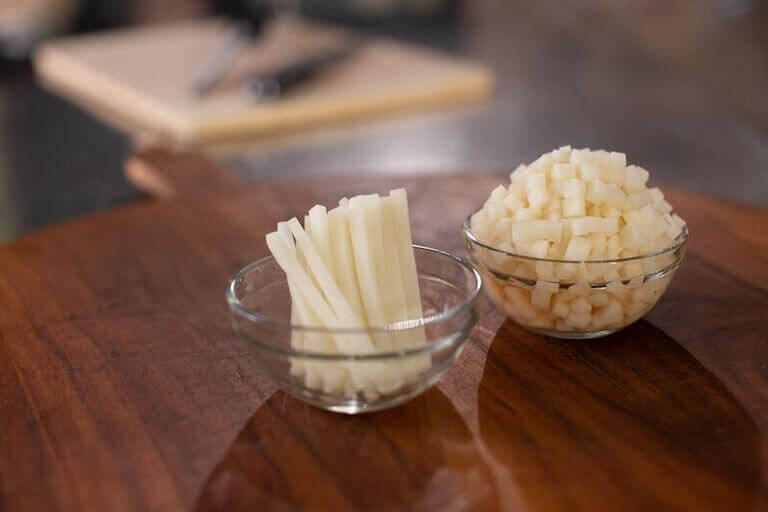
Getting perfectly sized potato cubes cubes can take some practice.
Proper knife technique can help you make perfectly vertical cuts. When it comes to getting consistently sized potato slabs, sticks, and cubes, avoid making assumptions. If you don’t feel confident about eyeballing your measurements, take the time to make a perfect cube, and then use it as a template. The culinary ruler is a great tool to get used to seeing the standard cube sizes. As you spend time working with your knife, your consistency and ability to judge size will likely improve. In other words, keep practicing!
Tips for How to Cube a Potato for Perfect Results
Though it can look intimidating to create those perfect piles of potato cubes, with a little practice, you can become proficient with the technique in no time. Here are a few tips.
Work One Potato at a Time
Don’t be in a rush. Work one potato at a time, and take your time carefully slicing your potato sticks and cubes. Trying to do too many pieces at once leaves you at risk for a knife injury and leads to inconsistent pieces. Be sure to practice good knife technique, and keep your fingers curled. As you practice, you’ll get better at estimating sizes.
Make Sure Your Knife is Sharp
It may seem like a no-brainer, but many kitchen injuries are caused by dull knives. A sharp knife can make cutting your potatoes effortless, preventing you from having to use a lot of dangerous force. Keep your knives sharp, and touch them up with a honing steel before cubing potatoes.
Store Cubed Potatoes in Cool Water
While you work on cubing your potatoes, store the finished pieces in cool water. This prevents your potatoes from browning before you get to cook them. You can store raw, cubed potatoes in water for up to 24 hours.
Cubed Potato Recipes
Now that you’ve learned how to cube a potato, it’s time to enjoy them! Try out these recipes to practice dicing potatoes.
Country Breakfast Potatoes
Country breakfast potatoes are a weekend favorite. They’re crispy, salty, always delicious, and they go well with eggs, a side of bacon, and fresh fruit.

Oven-roasted breakfast potatoes are a perfect use for medium-diced potatoes.
Ingredients:
- 6 large russet potatoes, cut into medium cubes (½” x ½” x ½”)
- 3 Tbsp olive oil or coconut oil
- 1 Tbsp paprika
- 1 Tbsp garlic powder
- 2 tsp mixed herbs, like dried or fresh thyme or rosemary (optional)
- Salt and pepper to taste
Instructions:
- Preheat oven to 450°F.
- Cube the potatoes.
- Mix all the ingredients in a bowl.
- Spread out on a sheet pan evenly.
- Bake for 35-45 minutes, until tender and evenly browned.
- Serve with fried, poached, or scrambled eggs and bacon, and top with ketchup, salsa, hollandaise sauce, hot sauce, cheese, sour cream, or whatever else you desire.
Chickpea & Potato Curry
By Escoffier Chef Instructor Bethany Schroeder
This classic Indian recipe uses a mild curry paste, allowing you to customize the heat level to your liking with added cayenne pepper.
Ingredients:
- 3 T mild cooking oil
Flavor Base:
- 1 large Spanish onion, medium diced (about 8oz)
- 2 large garlic cloves, minced
- 2 T mild curry paste (Patak’s Mild Curry Base)
- 1/4 tsp All Spice powder
- 1/4 tsp nutmeg powder
- 1 1/2 tsp smoked paprika
- 2 tsp dried thyme leaves (or 3 tsp fresh thyme leaves)
- 1 tsp cumin powder
- 1/4 tsp cayenne pepper, or less if you prefer a milder curry
- 1 tsp white pepper (or 1/2 tsp black pepper)
Curry:
- 1 1/2 cups potatoes or sweet potatoes, cut into 1/2″ cubes
- 28 oz canned chickpeas, drained and rinsed
- 14 oz small diced tomatoes, peeled and seeded
- 2 cups of favorite vegetables such as butternut squash, spinach,
- mushrooms, corn etc., medium to large diced
- 2 cups vegetable stock
- 2 scallion, sliced (green & white part)
- 12 oz unsweetened coconut milk
- 1 T cornstarch
- 2 T fresh parsley, chopped
- Salt to taste
- Toasted, unsweetened coconut and toasted cashew pieces to garnish
Instructions:
- Heat oil in a large pot or very deep skillet over medium high heat.
- Add the Flavor Base ingredients and cook for 3 minutes until the onion is translucent.
- Add the potatoes and cook for a further 10 minutes. If the spices start to stick to the
bottom of the pot, add a splash of water. - Add the tomatoes and vegetables (not spinach) and broth. Bring to simmer then turn
down the heat to medium and simmer for 20 minutes, or until the potatoes are cooked
and the sauce has thickened. - Combine coconut milk with 1 Tablespoon of cornstarch to form a slurry, then add to
curry while whisking and bring just to a boil. Simmer uncovered until desired thickness
is achieved. - Add chickpeas and spinach, cook for an additional 5 minutes until combined.
- Adjust salt to taste, stir through scallions and parsley.
- Serve with basmati rice and garnish with coconut and cashew pieces.
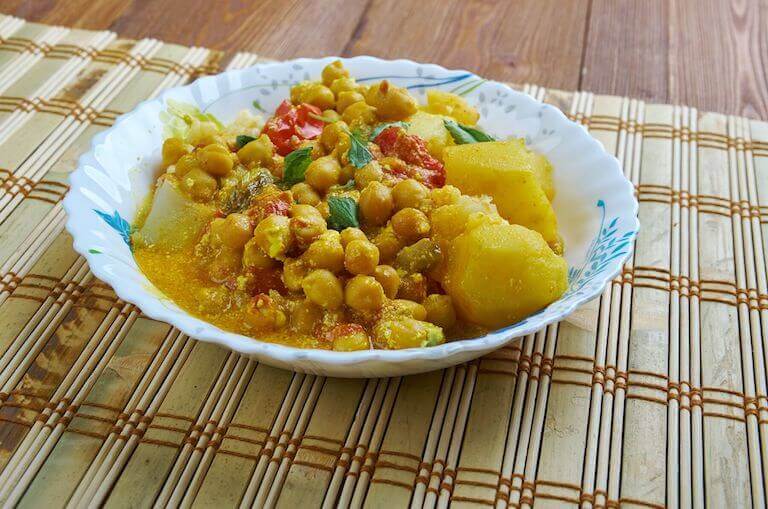
Chickpea & potato salad is bright and flavorful, and it doesn’t take too long to prepare.
Learn How to Cube a Potato Like a Professional
With good instruction and dedicated practice, nearly anyone can learn professional-level culinary skills like cubing a potato. People who are well-practiced at prep and cooking techniques are usually better able to find secure employment in all kinds of kitchens, including restaurants, caterers, hotels, and other hospitality businesses.
At Auguste Escoffier School of Culinary Arts, we take training our students in the fine art of prepping and mise en place seriously. If learning how to prep food like a sous chef excites you, learn more about how a degree or diploma in culinary arts can help you make your dreams a reality.
IF READING THIS ARTICLE ABOUT HOW TO CUBE A POTATO WAS INTERESTING, CONSIDER READING THESE ARTICLES NEXT:
- Knife Skills: 10 Knife Cuts Every Professional Cook Should Know
- Why Study at a French Culinary Institute
- How Long Can it Take to Become a Chef?
This article was originally published on May 2, 2014, and has since been updated.
